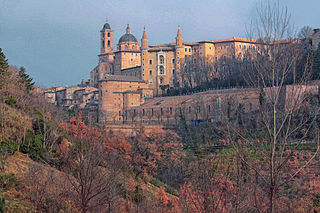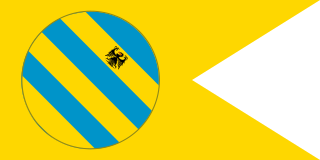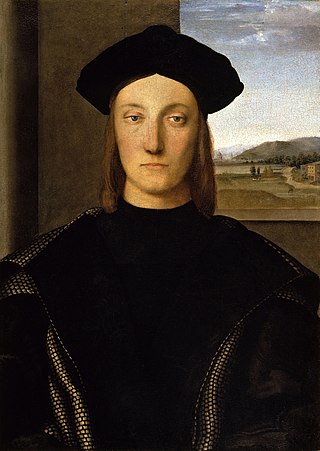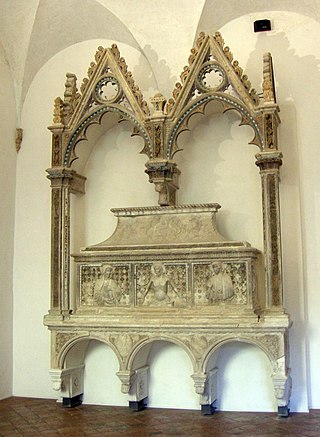Related Research Articles

Piero della Francesca was an Italian painter, mathematician and geometer of the Early Renaissance, nowadays chiefly appreciated for his art. His painting is characterized by its serene humanism, its use of geometric forms and perspective. His most famous work is the cycle of frescoes The History of the True Cross in the Basilica of San Francesco in the Tuscan town of Arezzo.
Federico II Paolo Novello da Montefeltro was the reigning Count of Urbino from 1364 until his death.

Urbino is a comune (municipality) in the Italian region of Marche, southwest of Pesaro, a World Heritage Site notable for a remarkable historical legacy of independent Renaissance culture, especially under the patronage of Federico da Montefeltro, duke of Urbino from 1444 to 1482.

Federico da Montefeltro, also known as Federico III da Montefeltro KG, was one of the most successful mercenary captains (condottieri) of the Italian Renaissance, and lord of Urbino from 1444 until his death. A renowned intellectual humanist and civil leader in Urbino on top of his impeccable reputation for martial skill and honour, he commissioned the construction of a great library, perhaps the largest of Italy after the Vatican, with his own team of scribes in his scriptorium, and assembled around him a large humanistic court in the Ducal Palace, Urbino, designed by Luciano Laurana and Francesco di Giorgio Martini.

The House of Montefeltro is the name of a historical Italian family who ruled Urbino and Gubbio and became Dukes of Urbino in 1443. The family extinguished in the male line in 1508 and the duchy was inherited by the Della Rovere family.

Justus van Gent or Joos van Wassenhove was an Early Netherlandish painter, perhaps from Ghent, who after training and working in Flanders later moved to Italy where he worked for Federico da Montefeltro, duke of Urbino, and was known as Giusto da Guanto, or in modern Italian Giusto di Gand etc. The artist is known for his religious compositions executed in the early Netherlandish idiom and a series of portraits of famous men, which show the influence of early Italian Renaissance painting.

The Duchy of Urbino was an independent duchy in early modern central Italy, corresponding to the northern half of the modern region of Marche. It was directly annexed by the Papal States in 1631.

Francesco Maria I della Rovere was an Italian condottiero, who was Duke of Urbino from 1508 to 1516 and, after retaking the throne from Lorenzo II de' Medici, from 1521 to 1538.

Giovanni Santi was an Italian painter and decorator, father of Raphael Sanzio. He was born in 1435 at Colbordolo in the Duchy of Urbino. He studied under Piero della Francesca and was influenced by Fiorenzo di Lorenzo. He was court painter to the Duke of Urbino and painted several altarpieces among other things. He died in Urbino.

Sant'Agata Feltria is a comune (municipality) in the Province of Rimini in the Italian region Emilia-Romagna, located about 125 kilometres (78 mi) southeast of Bologna and about 45 kilometres (28 mi) south of Rimini.

Guidobaldoda Montefeltro, also known as Guidobaldo I, was an Italian condottiero and the Duke of Urbino from 1482 to 1508.

Alessandro Sforza was an Italian condottiero and lord of Pesaro, the first of the Pesaro line of the Sforza family.
Guidantonio da Montefeltro was count of Urbino in Italy from 1403 until his death.

The Castle of Petroia is a castle near Gubbio in Umbria, Italy.

Eleonora Gonzaga, Duchess of Urbino (31 December 1493 – 13 February 1570 was Duchess and sometime regent of Urbino by marriage to Francesco Maria I della Rovere, duke of Urbino. She served as regent during the absence of her spouse in 1532.

Antonio II da Montefeltro (1348–1404) was an Italian condottiero and count of Urbino.
Antonio da Montefeltro (1445–1508) was an illegitimate son of Federico III da Montefeltro, duke of Urbino.

Ottaviano Fregoso was the Doge of the Republic of Genoa.
Gentile Brancaleoni, was the daughter of Bartolomeo Brancaleoni, Lord of Massa Trabaria and Count of Mercatello sul Metauro, and Giovanna Alidosi. The name "Gentile" is, now as then, both masculine and feminine; in fact, she was named after her paternal grandfather.

Bonconte I da Montefeltro was an Italian Ghibelline general. He led Ghibelline forces in several engagements until his battlefield death. Dante Alighieri featured Montefeltro as a character in the Divine Comedy.
References
- Ugolini, F. (1859). Vite dei conti e duchi di Urbino. Urbino.
{{cite book}}: CS1 maint: location missing publisher (link)